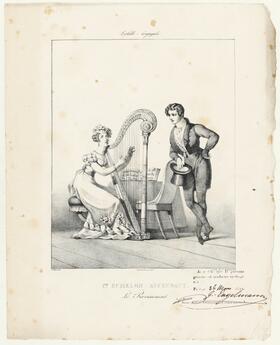Romantic Harp
In early nineteenth-century France, the harp was a very modern instrument, replacing the “baroque” harpsichord and competing with the pianoforte in a quest for “classical” expression.
Three areas of activity soon gave rise to a huge repertoire dedicated to the instrument. The development of salons explains the rapid dissemination of collections of pieces and romances of varying degrees of difficulty intended for enlightened amateurs. The concert hall was the venue where international virtuosos showcased the highest technical skill imaginable at the time in concertante works with orchestra. Finally, the harp began to stand out in the theatres: at the Opéra, it was used in divertissements to accompany ballets; at the Opéra-Comique, it appeared directly on stage as a decorative element, or was placed in the hands of a heroine who pretended to accompany herself. Between its different roles, the harp crystallised the appeal of a musical style that was still searching for its own identity and would soon find it: early romanticism was not far off.
Videos
Related persons
Related works
Andante et Scherzo op. 35 pour harpe et quatuor à cordes
Florent SCHMITT
Andante religioso
Henriette RENIÉ
Caprice pour violoncelle et harpe
Lucien DUROSOIR
Conte fantastique pour harpe et quatuor à cordes
André CAPLET
Danse sacrée et Danse profane
Claude DEBUSSY
Two Impromptus for harp
Jean CRAS
Fantaisie pour cor, harpe et piano
Lucien DUROSOIR
Prélude, Marine et Chanson
Guy ROPARTZ
Sonata for flute, viola and harp
Claude DEBUSSY
Suite en duo for flute and harp
Jean CRAS
Une châtelaine en sa tour op. 110
Gabriel FAURÉ
Permalink
publication date : 20/10/23
Back to the list of Focus














